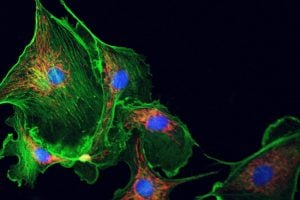
Responsive materials are synthetic substances that grow or shrink in reaction to outside forces such as moisture or temperature. This “movement” provides significant potential in biotechnology limited by the external oversight required.
Researchers at The Johns Hopkins University have devised a way for responsive materials to perform scripted, controlled movements after receiving internal marching orders. Their water-based responsive materials contain a combination of DNA sequences called hairpins (a reflection of their shape) and polymers. When the right DNA “message” is received, the gel expands.
The more messages the gel receives, the more it grows — up to 100 times its original size, according to Rebecca Schulman, an associate professor of chemical and biomolecular engineering at the Johns Hopkins Whiting School of Engineering. The growth can be stopped by introducing a “terminator hairpin.”
“You can control how much the gel grows or how it changes form using different biochemical signals,” says Schulman, who invented the technology along with David Gracias, a professor and director of graduate studies in the Department of Chemical and Biomolecular Engineering.
The gel swells in a manner reminiscent of the growing of a cell’s cytoskeleton, a network of fibers inside a cell that controls its shape and reconfigures to allow a cell to move. With the right DNA message, these gels could conceivably move or stretch cells grown on them.
A responsive material that allows for complex sensing, signal processing and feedback could have a variety of applications in addition to building or repairing tissues. The New England Journal of Medicine recently noted the gels could be injected into an aneurysm and programmed to expand in place of an implanted, coiled wire.
The responsive material also has applications in the field of microrobotics. Swarms of the gels could receive orders to detect dangerous bacteria — think “micro-Roomba,” Schulman says — bridging the gap between material science and robots. Such devices might be used for cleaning sensitive materials or performing cell repairs from the inside out, Schulman added.
Johns Hopkins Technology Ventures is actively pursuing patent protection for the technology.
To see more technologies, visit JHTV’s Technology Publisher site.